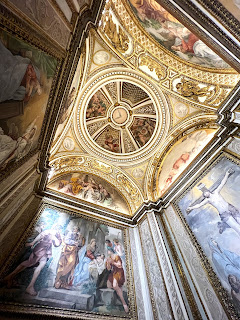One of the most magnificent villas in Rome, built by Maffeo Barberini, Pope Urban Vii in 1622, It was one of the largest private residences in Rome. The Barberini sold their palace to the state in 1949, which, with the Corsini palace, became the National Gallery. It is one of the most under-visited museums in Rome, competing with som many other famous collections (Vatican, Borghesi), and so Don and I almost had it to ourselves. It has the rather off-putting title of the National Gallery of Antique Art, which is a problematic title considering the presence of Caravaggio, Gentileschi, and others of the period. The building has two magnificent staircases, one by Bernini, and one by Borromini!
This was Don's and I last day in Rome, and we ended with one of our great meals in La Francesca.
The trip was life-altering in the sense that Rome was so much more than I could ever have imagined. What a treat to see it with my twin, who shared my enthusiasm with everything we did and saw. I think we both thought of the Borghese as the artistically most satisfying unified experience, and for me, personally, seeing the Forum from the Capitoline Hill, was an epiphany.
I've said it many times, but it needs to be said one more time: Thank you, Sally, and Neal, for your whole creative process in getting Don and I together in Rome. Of course, we both know how much more delightful the experience would have been with the two of you along to comment, point out, debate, postulate, ruminate, etc. etc. on all the art, architecture and food (!). How much better a glass of Barbaresco would have been if we could have shared it with you.
So we have to find a time in the future to do just that.
 |
 |
| Fra Angelico 1395-1455 Ascension, Last Judgement, Pentecost |
 |
| Il Perugino 1450-1523 St. Philip Benizi |
 |
| The Palazzo was the least decorated of all the palatial homes we visited, with the exception of a few magnificent ceilings |
 |
| Luce di Paolo 1435-1491 Adoring Angels |
 |
| Pietro Grill 1430-1498 The Archangel Michael |
 |
| Dei Crocifissi 1355-1399 Enthroned Virgin and Child with Saints |
 |
| detail of above |
 |
| Josse Lieferinxe 1493-1508 Pilgrims at the Tomb of St. Sebastian Fascinating work by a painter from Provence. |
 |
| Niccolo de Pietro 1394-1427 The Coronation of the Virgin |
 |
| Giambono 1420-1462 Virgin and Child Amazing frame and background, and truly amazing faces. |
 |
| The Bernini staircase |
 |
| Another beautiful ceiling |
 |
| Lorenzo Lotto 1480-1556 Mystical Marriage of St. Cahterine with Saints Jerome, George, Sebastian, Anthony Abbot, and Nicholas of Bari No wonder her eyes have a long-suffering look. |
 |
| Sodoma 1477-1549 The Rape of the Sabine Women There is some suggestion that Sodoma got his name from his close (make that very close) friendship with Rafael |
 |
| Bronzini 1503-1572 Portrait of Stefano IV Colonna A lieutenant general of the army of the Duke Cosimo de' Medici (AYGILTU?) |
 |
| detail |
 |
| Quentin Metsys 1466-1530 Portrait of Erasmus of Rotterdam |
 |
| Hans Holbein 1497-1543 Portrait of Henry VIII Ah, the arrogance, the smugness, the lust, the codpiece. Why couldn't he lose his head? |
 |
| Jeeeeze! |
 |
| Another ceiling panel. |
 |
| Maarten van Heemskerck 1498-1574 Lamentations over the Dead Christ Whaat aaa Greeaat Faace! |
 |
 |
| Bernini Portrait of Urbano VIII |
 |
| Jacopo Zucchi 1541-1596 Portrait of Clelia Farnese Jacopo's chef was the first cook to try cooking the long squash like vegetable, and so then it became known as................. |
 |
| Jacopo Robusti 1519-1594 Christ and the Adulteress Jacopo was a very healthy, muscular male, very............ |
 |
| Peeking out a window |
 |
| A European Goldfinch! (very tiny detail of a large painting). |
 |
| Paul Bril 1554-1626 View of Giove |
 |
| Caravaggio Narcissus A striking example of Chiaroscuro, or the use of strong contrasts between light and dark. |
 |
| Bernardo Strozzi 1581-1644 The Charity of St. Lawrence A remarkable and gifted artist. I must find out more about him. |
 |
| Artemisia Gentileschi 1593-1653 Allegory of Painting |
 |
| The huge ceiling in the main hall is by Pietro de Cortona entitled The Triumph of Divine Providence and the Fulfilment of its Purposes under Pope Urbin VIII Sucking up on the grandest possible scale. |
 |
| detail |
 |
| detail |


































